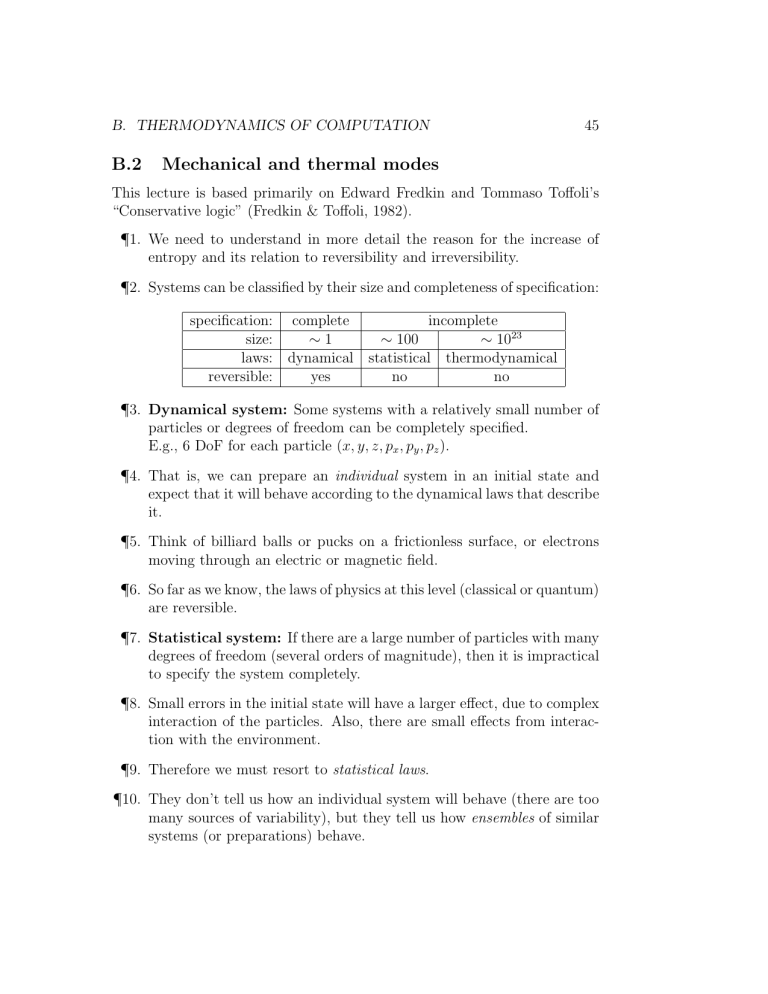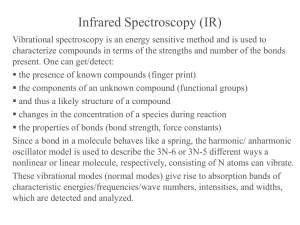B.2 Mechanical and thermal modes

B. THERMODYNAMICS OF COMPUTATION 45
B.2
Mechanical and thermal modes
This lecture is based primarily on Edward Fredkin and Tommaso To ↵ oli’s
“Conservative logic” (Fredkin & To ↵ oli, 1982).
¶ 1. We need to understand in more detail the reason for the increase of entropy and its relation to reversibility and irreversibility.
¶ 2. Systems can be classified by their size and completeness of specification: specification: complete incomplete size: ⇠ 1 ⇠ 100 ⇠ 10 23 laws: dynamical statistical thermodynamical reversible: yes no no
¶ 3.
Dynamical system: Some systems with a relatively small number of particles or degrees of freedom can be completely specified.
E.g., 6 DoF for each particle ( x, y, z, p x
, p y
, p z
).
¶ 4. That is, we can prepare an individual system in an initial state and expect that it will behave according to the dynamical laws that describe it.
¶ 5. Think of billiard balls or pucks on a frictionless surface, or electrons moving through an electric or magnetic field.
¶ 6. So far as we know, the laws of physics at this level (classical or quantum) are reversible.
¶ 7.
Statistical system: If there are a large number of particles with many degrees of freedom (several orders of magnitude), then it is impractical to specify the system completely.
¶ 8. Small errors in the initial state will have a larger e ↵ ect, due to complex interaction of the particles. Also, there are small e ↵ ects from interaction with the environment.
¶ 9. Therefore we must resort to statistical laws .
¶ 10. They don’t tell us how an individual system will behave (there are too many sources of variability), but they tell us how ensembles of similar systems (or preparations) behave.
46 CHAPTER II. PHYSICS OF COMPUTATION
¶ 11. We can talk about the average behavior of such systems, but we also have to consider the variance, because unlikely outcomes are not impossible.
For example, tossing 10 coins has a probability of 1 / 1024 of turning up all heads.
¶ 12. Statistical laws are in general irreversible (because there are many ways to get to the same state).
¶ 13.
Thermodynamical system: Macroscopic systems have a very large number of particles ( ⇠ 10 23 ) and a correspondingly large number of
DoF. “Avogadro scale” numbers.
¶ 14. It is important to grasp how truly enormous these numbers are; in comparison (Tong, 2012, p. 37):
# grains of sand on all beaches ⇡ 10 18
# stars in our galaxy ⇡ 10 11
# stars in the visible universe ⇡ 10 22 but # water molecules in a cup of tea ⇡ 10 23 .
¶ 15. Obviously such systems cannot be completely specified (we cannot describe the initial state and trajectory of every atom).
¶ 16. We can derive statistical laws, but in these cases most macrostates become so improbable that they are virtually impossible: Example: the cream unmixing from your co ↵ ee.
The central limit theorem shows that the variance decreases with n .
¶ 17. In the thermodynamic limit, the likely is inevitable , and the unlikely is impossible .
¶ 18. In these cases, thermodynamical laws describe the virtually deterministic (but irreversible ) dynamics of the system.
¶ 19.
Mechanical vs. thermal modes: Sometimes in a macroscopic system we can separate a small number of mechanical modes (DoF) from the thermal modes .
“Mechanical” includes “electric, magnetic, chemical, etc. degrees of freedom.”
B. THERMODYNAMICS OF COMPUTATION 47
¶ 20. The mechanical modes are strongly coupled to each other but weakly coupled to the thermal modes.
(e.g., bullet, billiard ball)
¶ 21. Thus the mechanical modes can be treated exactly or approximately independently of the thermal modes.
¶ 22.
Conservative mechanisms: In the ideal case the mechanical modes are completely decoupled from the thermal modes, and so the mechanical modes can be treated as an isolated (and reversible) dynamical system.
¶ 23. The energy of the mechanical modes (once initialized) is independent of the energy ( ⇠ kT ) of the thermal modes.
¶ 24. The mechanical modes are conservative ; they don’t dissipate any energy.
¶ 25. This is the approach of reversible computing.
¶ 26.
Damped mechanisms: Suppose we want irreversible mechanical modes, e.g., for implementing irreversible logic.
¶ 27. The physics is reversible, but the information lost by the mechanical modes cannot simply disappear; it must be transferred to the thermal modes. This is damping .
Information in the mechanical modes, where it is accessible and usable, is transferred to the thermal modes, where it is inaccessible and unusable.
Thermalization of information.
¶ 28. But the transfer is reversible, so noise will flow from the thermal modes back to the mechanical modes, making the system nondeterministic.
¶ 29. “If we know where the damping comes from, it turns out that that is also the source of the fluctuations ” [Feynman, 1963].
Think of a bullet ricocheting o ↵ a flexible wall filled with sand. It dissipates energy into the sand and also acquires noise in its trajectory
(see Fig. II.6).
48 CHAPTER II. PHYSICS OF COMPUTATION
Figure II.6: Complementary relation of damping and fluctuations.
¶ 30. To avoid nondeterminacy, the information may be encoded redundantly so that the noise can be filtered out.
I.e., signal is encoded in multiple mechanical modes, on which we take a majority vote or an average.
¶ 31. The signal can be encoded with energy much greater than any one of the thermal modes, E kT , to bias the energy flow from mechanical to thermal preferring dissipation to noise).
¶ 32.
Signal regeneration: Free energy must refresh the mechanical modes and heat must be flushed from the thermal modes.
¶ 33. “[I]mperfect knowledge of the dynamical laws leads to uncertainties in the behavior of a system comparable to those arising from imperfect knowledge of its initial conditions. . . Thus, the same regenerative processes which help overcome thermal noise also permit reliable operation in spite of substantial fabrication tolerances.”
¶ 34. Damped mechanisms have proved to be very successful, but they are inherently ine ffi cient.
¶ 35. “In a damped circuit, the rate of heat generation is proportional to the number of computing elements, and thus approximately to the useful volume; on the other hand, the rate of heat removal is only proportional to the free surface of the circuit. As a consequence, computing circuits using damped mechanisms can grow arbitrarily large in two dimensions only, thus precluding the much tighter packing that would be possible in three dimensions.”
B. THERMODYNAMICS OF COMPUTATION 49
¶ 36.
Decoherence: In an extreme case, a signal’s interacting with the environment might cause it to lose its coherence (the correlation of its constituent DoFs, such as the correlation between the positions and momenta of its particles).
The information implicit in the mechanical modes is lost into the thermal modes.







